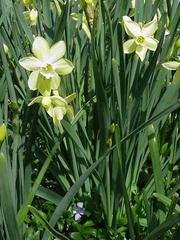
If you haven’t thought about it yet, now is a good time to plant your daffodils and other spring bulbs. The ones I ordered still await my tender ministrations and I hope to get them all into the ground this coming weekend. Of course, first I have to rake up the mountain of leaves, obligingly dropped over the past few days by the maple tree out front. Some excellent planting spots are currently submerged under that mountain, so it makes sense to start by removing it. I try to reduce the tedium inherent in leaf clearing by thinking about how beautiful the garden will look next spring when the leaves are long gone and the daffodils are blooming.
Most people who know bulbs think of the Netherlands, which is the world’s largest supplier of daffodils, not to mention tulips, crocuses, hyacinths and other spring-blooming beauties. The Dutch have long bred, grown and exported the plants and flower lovers can only be grateful. However, they are not the only players in the bulb breeding game. The world is full of dedicated narcisso-philes, who put all their energy into breeding narcissi, commonly known as daffodils. And many of the best daffodils have been and continue to be bred in the United States.
One of the most celebrated American daffodil breeders was Grant Mitsch—1907-1989–of Canby, Oregon. As with many noted horticulturists, Mitsch started his career early. As a teenager, he helped a local Presbyterian minister and gladiola enthusiast with the annual lifting of the gladiola corms in the fall. He began selling surplus gladiola corms at the age of 20. Shortly thereafter, he was introduced to his life’s passion, daffodils, and in 1934, began breeding them. Though he bred, grew and sold other plants, daffodils became in increasing focus, and by the time Mitsch reaching his forties, he concentrated exclusively on narcissus. His business, Grant E. Mitsch Novelty Daffodils offered his own hybrids, as well as the best daffodils bred by others.
I remember that Pauline Henry, the great American daylily breeder, once said that she bred “pretty on pretty” to produce the most beautiful daylilies. Grant Mitsch seemed to do the same with daffodils. He worked, early in his career, on producing better pink-cupped varieties, using the groundbreaking English cultivar, ‘Mrs. R.O. Backhouse’ as one of his foundation plants . Many pink or salmon-cupped offspring resulted. One of the best, ‘Accent’, with a coral to salmon cup and white perianth or surrounding petals, was registered in 1987 and is still popular today.
Though Mitsch worked with all shapes, sizes and types of narcissus, much of his work centered on varieties grouped into three of the Royal Horticultural Society’s 13 narcissus categories: Triandrus, Cyclamineus and Jonquilla/Apodanthus. Triandrus varieties feature two or more pendant flowers per stem, often with reflexed or back-curving petals. Cyclamineus types bear one flower per stem, with reflexed perianth petals. Each flower generally forms an acute angle with the stem and is attached to the stalk by a very short pedicels or “neck”. Jonquillas often boast up to five flowers per stem, with the perianth petals either spreading or reflexed. Jonquillas are often fragrant as well, and succeed in the warmer climates that are less congenial to many daffodils.
Among the best-known—and still available–of the Mitsch jonquillas is ‘Pipit’, registered in 1963. With the slender profile typical of jonquillas, ‘Pipit’ features two to three flowers per stem. Each bloom starts out bright yellow, but matures to white. The plants grow fourteen to sixteen inches tall.
A triandrus type, ‘Petrel’, introduced in 1970, is one of many daffodils that Mitsch named after bird varieties. Petrel bears three to five pure white, fragrant blooms per stem on plants that rise between 12 and 14 inches. Like other triandrus, cyclaminus and jonquilla types, ‘Petrel’ is equally at home planted in-ground or in containers.
Eventually, Mitsch’s daffodil business and breeding efforts were taken over by his daughter, Elise Mitsch Havens and her husband, Richard in 1978. Like Grant Mitsch, the Havens issued a small daffodil catalog, which was renowned among daffodil fanciers for the quality and variety of its offerings. The Havens kept the enterprise going and thriving until just a couple of years ago, when Richard Havens died. Daffseek, the database of the American Daffodil Society, lists 655 Mitsch-registered varieties and an additional 59, registered to Mitsch and Havens. Many are no longer available, but the sheer numbers are impressive.
There is still time to buy a few daffodil bulbs and get them in the ground before the soil hardens into concrete and the desire to be out in the elements lessens. It takes a bit of checking to find Mitsch bulbs, but try the “Search” feature at the Dave’s Garden website–https://davesgarden.com/sitewidesearch.php?q=Mitsch. In the meantime, you can Buy ‘Pipit’, ‘Petrel’ and ‘Accent’ from Brent and Becky’s Bulbs, 7900 Daffodil Lane Gloucester, VA 23061; (804) 693-3966 or Toll-free (877) 661-2852; www.brentandbeckysbulbs.com. Free paper catalog.
